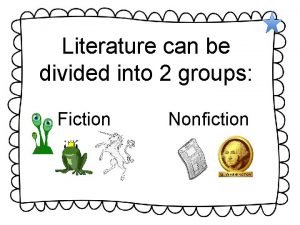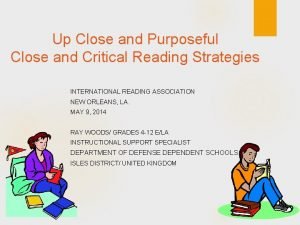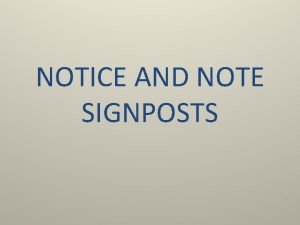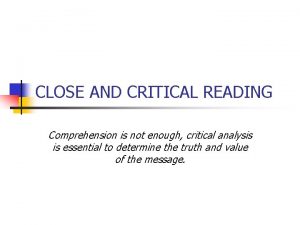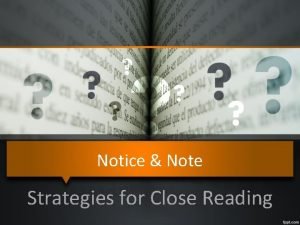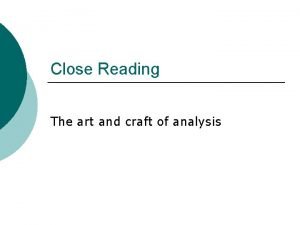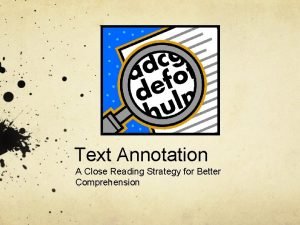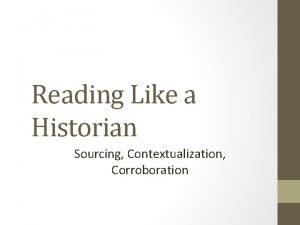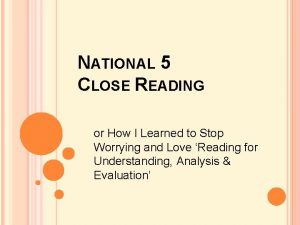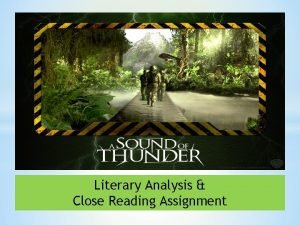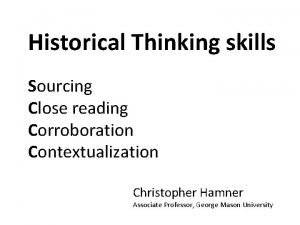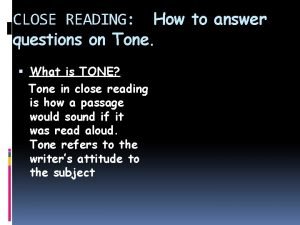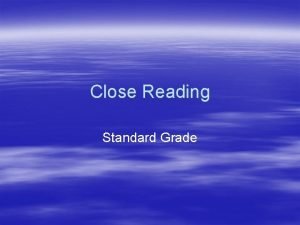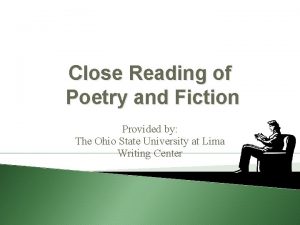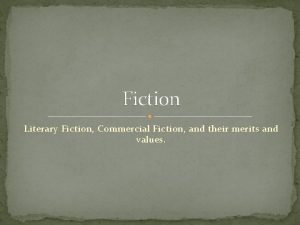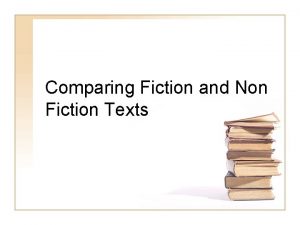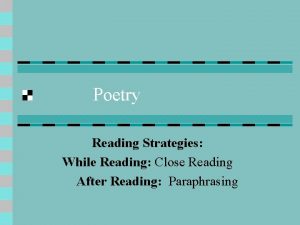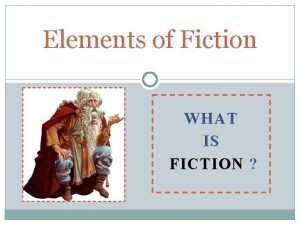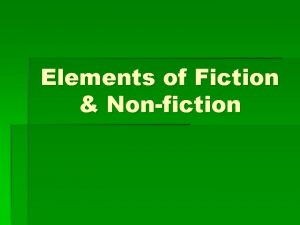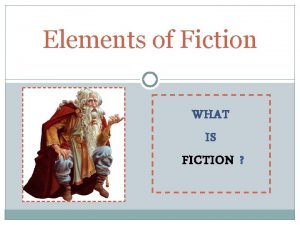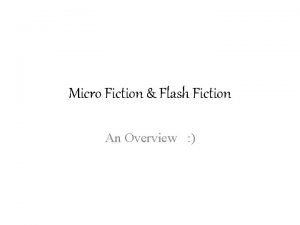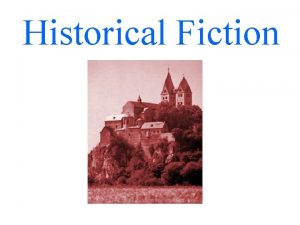Close Reading of Poetry and Fiction Close Reading




















- Slides: 20

Close Reading of Poetry and Fiction

Close Reading – An Overview Literary Analysis requires that one read the text by looking closely at both what the author is saying and how the author is saying it. When conducting a close reading, readers should look at the small details and understand how they work together in the piece to create meaning.

Part 1 How to Tackle the Ever-Daunting Task of Close Reading

How to Read Closely When reading, look at passages that seem important in the text. Underline or highlight or take notes on passages that stand out. Things you might look for: ◦ Symbolism ◦ Repeated images, words or ideas ◦ Words or phrases that jump out as important ◦ Words or phrases that can be interpreted in more than one way ◦ Irony or ambiguity ◦ Passages you don’t understand ◦ Figurative language

How to Read Closely Before you look too closely at what you’ve marked, make sure you understand the basic plot and characters. ◦ Look at characters and their roles in the work. Try paraphrasing passages you don’t understand. Look for associations of words that are unexpected or unusual. For example: ◦ An angel is normally associated with cleanliness and purity. ◦ Passages that emphasize dirtiness might be important.

How to Read Closely Look up the meanings of words! There may be a meaning that you didn’t think of before, or a word that may have had different meanings at different times in history. A good resource for looking up words is the Oxford English Dictionary (OED). ◦ The OED provides definitions of words relevant to specific time periods.

How to Read Closely Re-read passages you did not understand the first time. Never ignore anything that you don’t understand. Keep working at difficult passages until they make sense.

How to Read Closely– Now what? After reading and making note of important passages, try to find a unifying idea. First, ask what the elements seem to be saying. Any idea supported by the text is valid. There are no “crazy” or “stupid” ideas, unless there is no evidence from the text to support the claim. Don’t try to relate everything you find in the story. Use the parts that create one unifying idea. ◦ However, don’t ignore anything that contradicts this unifying idea. Remember to present and discuss any contradicting evidence you find.

How to Read Closely – Unifying Idea If you have trouble finding a unifying idea: Try writing about ideas in the work that interest you. ◦ By writing down your ideas you may begin to see connections you did not see before. The thesis (unifying idea) should point to something about the text that people might not otherwise have realized. If no one would argue your point, ask “So what? ” ◦ Sometimes the answer to this question is thesis.

Part 2 Close Reading: Fiction Excerpt from Herman Melville’s “Benito Cereno”

“Benito Cereno” by Herman Melville The morning was one peculiar to that coast. Everything was mute and calm; everything gray. The sea, though undulated into long roods of swells, seemed fixed, and was sleeked at the surface like waved lead that has cooled and set in the smelter’s mould. The sky seemed a gray surtout. Flights of troubled gray fowl, kith and kin with flights of troubled gray vapors among which they were mixed, skimmed low and fitfully over the waters, as swallows over meadows before storms. Shadows present, foreshadowing deeper shadows to come. Melville, Herman. “Benito Cereno. ” Nation of Letter: A Concise Anthology of American Literature. Ed. Stephen Cushman and Paul Newlin. Vol. 1. St. James: Brandywine P, 1998. 278 -315.

Sentence 1 The morning was one peculiar to that coast. Morning - ideas of a new day or beginning, light, sunrise Peculiar - means distinct, characterizes a person place or thing, also the idea of different Coast - near the sea, establishes setting

Sentence 2 Everything was mute and calm; everything gray. Mute - silent Calm - tranquil, peaceful, quiet, everything is quiet and gray Gray - color between black and white, dull, the cold of light at twilight, not bright or hopeful, dismal, gloomy, sad, depressing, cold and sunless

Sentence 3 The sea, though undulated into long roods of swells, seemed fixed, and was sleeked at the surface like waved lead that has cooled and set in the smelter’s mould. Undulated - wavy markings, forming a waved surface Roods - one meaning is a cross or a representation of a cross, another is a unit of linear measurement, Swells - rising or heaving of the sea/water in succession of long rolling waves, as after a wind causing it has dropped, or due to a distant disturbance Fixed - fastened securely, firmly resolved, stationary Lead - gray, heavy metal Smelter - one who fuses metal— Here there is a Paradox - the sea is moving, has swells and undulated waves, yet it seems fixed, sleeked at the surface, and like lead There is also a simile - the water is like lead

Sentence 4 The sky seemed a gray surtout. The color GRAY has become a dominant theme by this point. ◦ May be important in the work— take note of the color, perhaps; Surtout - a man’s great-coat or overcoat; a hood worn by women; outer covering ◦ (We know from the OED that the word is obsolete now. )

Sentence 5 Flights of troubled gray fowl, kith and kin with flights of troubled gray vapors among which they were mixed, skimmed low and fitfully over the waters, as swallows over meadows before storms. Kith and Kin - country and kinsfolk, relatives, family Vapors - matter in the form of a steamy or imperceptible exhalation, exhalation of nature of steam, usually due to the effect of heat on moisture; used figuratively to mean something insubstantial or worthless, sometimes to mean a fantastic idea, foolish brag or boast Skim - to deal with, treat, or study very lightly without close attention, move over something with very slight contact, glance over without reading closely, pass over lightly without dwelling on or treating fully

Sentence 5 (continued) Flights of troubled gray fowl, kith and kin with flights of troubled gray vapors among which they were mixed, skimmed low and fitfully over the waters, as swallows over meadows before storms. Storm - violent disturbance of affairs, whether civil, political, social, or domestic, commotion, sedition, tumult So the birds—Fowl—are relatives in some way to the vapors—what does this mean? Why are they troubled? Note that there is more gray—These fowl are like “swallows over meadows before storms”—does this mean these “fowl” are foreshadowing a storm, as well (commonly believed that animals have some weather predicting capabilities)? Is this a literal storm, or also some sort of storm in the story itself?

Sentence 6 Shadows present, foreshadowing deeper shadows to come. Shadow - comparative darkness, gloom, unhappiness, darkness of night or growing darkness after sunset; image cast by a body intercepting light; type of what is fleeting or ephemeral; delusive semblance or image; vain/unsubstantial object of pursuit; obscure indication, symbol, foreshadowing; imitation, copy; slight or faint appearance, small portion, trace ◦ (Note how many meanings for one simple word that we all think we know) Deeper - extension downward; profound, hard to get to the bottom of; grave, heinous; intense, profound, great in measure/degree; intense (color); penetrating; much immersed, involved, implicated, far advanced, far on

Sentence 6 (continued) Shadows present, foreshadowing deeper shadows to come. These shadows are also gray. Shadows foreshadowing deeper shadows might be all signs on the water of a coming storm—the waves, the quiet, the birds, the vapors—how does this relate to the story? Are their “deeper shadows” to come yet in the story itself? The story itself starts gray, in shadow-like environment on the sea—also the word “foreshadowing” is in the passage.

Draft a thesis You may want to use a format such as this: The (adjective)(lit element) and (adjective)(lit element) in Herman Melville’s “Benito Cereno” convey a tone of (adverb) (adjective) that (So What). Example: The gloomy imagery and disquieting foreshadowing in Herman Melville’s “Benito Cereno” convey a tone of alarming foreboding that puts the reader on heightened alert.
 Characteristics of nonfiction
Characteristics of nonfiction Fictional character examples
Fictional character examples Science fiction
Science fiction Contemporary realistic fiction vs historical fiction
Contemporary realistic fiction vs historical fiction While reading activities
While reading activities Close and critical reading
Close and critical reading Signposts in reading
Signposts in reading Close and critical reading
Close and critical reading Notice and note close reading
Notice and note close reading The santa ana winds joan didion annotation
The santa ana winds joan didion annotation Medias res
Medias res Close reading symbols
Close reading symbols Sourcing contextualization corroboration
Sourcing contextualization corroboration National 5 close reading
National 5 close reading What is the climax in a sound of thunder
What is the climax in a sound of thunder Sourcing contextualization corroboration close reading
Sourcing contextualization corroboration close reading Close reading teksten groep 4
Close reading teksten groep 4 Ruae link questions
Ruae link questions Close reading definition
Close reading definition Tone questions examples
Tone questions examples Close reading objectives
Close reading objectives

